Silent Era Home Page > Home Video > The Lost World

Reviews of silent film releases on home video.
Copyright © 1999-2024 by Carl Bennett
and the Silent Era Company.
All Rights Reserved. |
|
The
Lost World
(1925)
|
Among the most beloved films of the first one hundred years of motion pictures is King Kong (1933). Among the many people who worked on that film, the one person most responsible for its enduring success was master animator Willis O’Brien. The Lost World (1925) represented O’Brien’s artistic coming of age as a stop-motion animator.
In this modern day when stop-action animation has been surpassed by computer-developed special effects, we may want to take a historical look back at the road motion picture special effects have taken. One milepost on that road is this adaptation of Sir Arthur Conan Doyle’s story of live dinosaurs surviving in a remote South American jungle.
Any viewing of this film requires a brief historical explanation of the incomplete state in which The Lost World has survived. Early in 1925, The Lost World was released in its original ten-reel roadshow version. Contemporary accounts have listed the original running time at between 104 and 108 minutes (depending on the speed of the theater’s projector, of course) and at a length of more than 9200 feet. In 1929, the widow of the film’s producer (who held the motion picture rights to the story) entered into an agreement with the film’s distributor to withdraw The Lost World from circulation. At that time, to satisfy the terms of the agreement, all known positive prints and the alternate ‘foreign export’ negative were destroyed. (Some theories maintain that the way was being cleared for the production of King Kong, which has a moderately similar story line to The Lost World.)
At the same time, the film’s distributor, First National, authorized Kodascope Libraries Inc. to issue a five-reel abridgement of The Lost World in 16mm reduction prints that were intended for distribution to schools, churches, institutions, etc. The edited 35mm duplicate negative utilized to create subsequent 16mm Kodascope negatives survived the years and eventually ended up at the George Eastman Museum in the 1950s. Other than the original trailer, some 365 feet of 35mm exerpts held at the Library of Congress, other surviving fragments in two private collections and eight minutes of 35mm positive print O’Brien animation outtakes, the abridged George Eastman Museum duplicate negative represented the finest and most complete (with 40 percent of its original length lost) 35mm print of The Lost World.
Entire sections of the narrative, whole characters and locations, and much of the character development had been excised from the Kodascope edition of the film. And while we are deprived of the development of the characters that remain, we are left with the majority of the action sequences. Much of O’Brien’s work remains for us to enjoy.
The story of The Lost World doesn’t end with its surviving Kodascope version, however. In 1992, a nearly complete 35mm print of The Lost World (probably struck from the alternate foreign negative) was revealed to the world as being held at the Filmovy Archiv in Prague, Czechoslovakia. A reconstruction project was initiated by George Eastman Museum, headed by GEM’s Ed Stratmann, and more than $80,000 was collected from benefactors to defray the expenses of the effort. In 1997, George Eastman Museum debuted the almost wholly reconstructed Lost World, which now totalled more than 8000 of its original 9200 feet. Of the missing footage, most of it remains lost in the form of minor print break splices, damaged reel ends and shortened running times on intertitles (which ran long for slower-reading contemporary audiences). Among of the still-missing footage is the cannibal attack sequence in the Amazon jungle.
In 2000, we viewed a print of the GEM reconstruction edition of The Lost World and were generally pleased with the results. A number of missing sections were implied by production photographs and expositional intertitles. The image quality was excellent but it was clear that the Kodascope negative was still the primary source for the GEM reconstruction. The best home video representation of the reconstruction appears on the 2007 Fox DVD noted here.
In 2016, a new restoration version was completed by Lobster Films, Paris, assembled from eleven separate print sources to provide what is touted to be the most complete version of the film to be viewed since the 1920s. An additional eight minutes of footage was restored to the film. The insert booklet from the 2017 Blu-ray Disc edition of the film documents the source material as an incomplete 35mm nitrate domestic positive print of reels 3, 5, 6 and 9 from the Lobster Films collection; a longer but incomplete 35mm safety print of the Czech release version held by the National Film Archive; a 35mm color-tinted nitrate print of the Czech film trailer held by the Archive of Modern Conflict; a brief 35mm safety positive held by the Academy of Motion Picture Arts and Sciences (Blackhawk Films collection); 35mm nitrate positives of camera test footage held by the Library of Congress and the UCLA Film and Television Archive; and 35mm nitrate positive print fragments held by the Library of Congress and George Eastman Museum. Additional footage, not at all present in original prints of the film, was taken from a 35mm safety print of a Movietone sound film short taken of Sir Arthur Conan Doyle held by the Academy of Motion Picture Arts and Sciences (Blackhawk Films collection).
— Carl Bennett
|
 Flicker Alley Flicker Alley
2017 Blu-ray Disc edition
The Lost World (1925), color-toned black & white, 110 minutes, not rated,
with R.F.D., 10,000 B.C. (1917), black & white, 9 minutes, not rated, The Ghost of Slumber Mountain (1918), black & white, 13 minutes, not rated, and Creation (1930), black & white, 5 minutes, not rated.
Flicker Alley, FA0053, UPC 6-17311-68539-2.
One single-sided, dual-layered, Regions ABC Blu-ray Disc, 1.33:1 aspect ratio image in pillarboxed 16:9 (1920 x 1080 pixels) progressive scan MPEG-4 format, SDR (standard dynamic range), 36.0 Mbps average video bit rate, 2.3 Mbps audio bit rate (5.1 sound) and 448 Kbps audio bit rate (2.0 sound), LPCM 48 kHz 24-bit 5.1 surround sound and Dolby Digital 48 kHz 8-bit 2.0 stereo sound, English language intertitles, no foreign language subtitles, 13 chapter stops; standard BD keepcase; $39.95.
Release date: 12 September 2017.
Country of origin: USA
Ratings (1-10): video: 9 / audio: 9 / additional content: 7 / overall: 8.
|

This Blu-ray Disc edition has been remastered in 2K high-definition from the 2016 reconstruction version, which now includes approximately eight minutes of recently-recovered footage. Produced by Serge Bromberg of Lobster Films and dedicated to the late David Shepard of Film Preservation Associates, this edition is now be the definitive home video edition of The Lost World.
The source material appears to be from both domestic and foreign versions of the film as some footage is slightly different from footage found in other print versions, taken at the same time but from a second camera angle to produce a B-camera negative typically used for export film prints. Some of the source material is worn, with a haze of fine print scratches, which cannot be missed in high-resolution. Of course, some of the source material is quite detailed coming from what appears to be first generation 35mm nitrate prints while some material appears to be from 35mm duplicate prints of varying ages — with the same range of image tones as the nitrate material but softer in image details.
Some sequences in this version have been restructured, compared to previous restorations, as additional footage adds clarity to the narrative of a scene. Among the new footage are establishing shots, lengthened shots and inset shots not previously seen in other restoration assemblages.
We are annoyed that more care wasn’t taken with the typography of the entirely reset intertitles of this version. While a computer-based typefont named Silentina may have been the authentic-looking font of choice here, which is quite a close match to the unknown font that was in common use in the intertitles of the 1920s, not enough care was taken in the replication of the type spacing, tracking and leading of the font to avoid the sometimes clumsy typesetting examples of this version, which was not seen in silent era films. The typographical mispellings of words in a very few of the intertitle cards is by far the most annoying, yanking this reviewer out of the narrative every time this version is viewed. This is nitpicking, to be sure, but it is also an often overlooked detail in silent film restoration.
The film is presented with an excellent new music score composed, adapted and conducted by Robert Israel and performed by a full orchestra. We are quite enthusiatic about this music and applaud its first-class treatment here. The music is entertaining and always sets the right tone for the film’s narrative.
The supplementary material includes restored outtakes from a 1925 original nitrate transfer of The Lost World; R.F.D., 10,000 B.C. (1917) the short Edison film produced and directed by Willis O’Brien; The Ghost of Slumber Mountain (1918) a short film written and directed by Willis O’Brien, in a new 2K HD restoration by the Dinosaur Museum; Creation (1930) an unfinished film directed by Willis O’Brien; audio commentary by Nicolas Ciccone; and an insert booklet featuring “The Lost World: Secrets of the Restoration” by Serge Bromberg of Lobster Films. R.F.D., 10,000 B.C. is presented from a good 16mm reduction print, without accompanying music. The Ghost of Slumber Mountain is presented in the 2016 restoration produced by The Dinosaur Museum of Blanding, Utah, with music by Terry Huud and commentary by Mark Wolf. The restoration materials were a contrasty but fair 16mm reduction print, a good (what appears to be) 35mm duplicate print, and an excellent 35mm print, which were provided for the restoration by the Academy of Motion Pictures Arts and Sciences, Film Preservation Associates and Lobster Films.
Overall, this Blu-ray Disc edition is great viewing with footage and image detail not seen in previous home video editions. This is our highly-recommended home video edition of The Lost World.
|
|
This Regions ABC Blu-ray Disc edition is available directly from . . .
|

|
|
 Twentieth Century Fox Twentieth Century Fox
Home Entertainment
2007 DVD edition
The Lost World (1960), color, 96 minutes, not rated (USA) and Rated PG (Canada),
with The Lost World (1925), color-tinted black & white, 76 minutes, not rated (USA) and Rated PG (Canada).
Twentieth Century Fox Home Entertainment,
unknown catalog number, UPC 0-24543-45965-1.
One single-sided, single-layered, Region 1 NTSC DVD disc, 1.33:1 aspect ratio image in full-frame 4:3 (720 x 480 pixels) interlaced scan MPEG-2 format, SDR (standard dynamic range), 7.0 Mbps average video bit rate, 192 Kbps audio bit rate, Dolby Digital 48 kHz 8-bit 2.0 stereo sound, English language intertitles, no foreign language subtitles, no chapter stops; standard two-disc DVD keepcase; $19.98.
Release date: 2007.
Country of origin: USA
Ratings (1-10): video: 8 / audio: 9 / additional content: 7 / overall: 8.
|

This DVD edition features an excellent high-definition video transfer from the very-good to excellent 1997 35mm restoration print from the George Eastman Museum.
The film is accompanied by an excellent music score performed on theatre pipe organ by Philip Carli.
We still recommend the Flicker Alley Blu-ray Disc edition noted above, but this edition is the best presentation of the 1997 George Eastman Museum restoration version of the film.
|
|
USA: Click the logomark to purchase this Region 1 NTSC DVD edition from Amazon.com. Your purchase supports Silent Era.
|

|
|
|
Canada: Click the logomark to purchase this Region 1 NTSC DVD edition from Amazon.ca. Your purchase supports Silent Era.
|

|
|
 Flicker Alley Flicker Alley
2015 DVD edition
The Lost World (1925), color-toned black & white, 93 minutes, not rated.
Flicker Alley, FA-MD3-005, unknown UPC number.
One single-sided, dual-layered?, Region 0 NTSC DVD-R disc, 1.33:1 aspect ratio image in full-frame 4:3 (720 x 480 pixels) interlaced scan MPEG-2 format, SDR (standard dynamic range), ? Mbps average video bit rate, ? Kbps audio bit rate, Dolby Digital 48 kHz 5.1 surround sound and Dolby Digital 48 kHz 2.0 stereo sound, English language intertitles, no foreign language subtitles, chapter stops; standard DVD keepcase; $19.95.
Release date: 18 March 2015.
Country of origin: USA
|
|
This DVD-R edition should be of identical quality to the 2001 Image edition noted directly below. Read our comments there for an idea of what to expect from this edition. Produced by Serge Bromberg of Lobster Films and David Shepard of Film Preservation Associates, this edition replaces the now out-of-print Image edition.
The film is presented with a pleasant small-orchestra music score compiled from contemporary theatrical sheet music by Rodney Sauer and performed by the Mont Alto Motion Picture Orchestra.
|
|
This Region 0 NTSC DVD-R edition is available directly from . . .
|

|
|
 Film Preservation Associates Film Preservation Associates
2001 DVD edition
The Lost World (1925), color-toned black & white, 93 minutes, not rated.
Film Preservation Associates, distributed by Image Entertainment, ID0319DSDVD, UPC 0-14381-03192-8.
One single-sided, dual-layered, Region 1 NTSC DVD disc (reissued on DVD-R disc), 1.33:1 aspect ratio image in full-frame 4:3 (720 x 480 pixels) interlaced scan MPEG-2 format, SDR (standard dynamic range), 6.5 Mbps average video bit rate, 448 and 224 Kbps audio bit rates, Dolby Digital 48 kHz 8-bit 5.1 surround sound and Dolby Digital 48 kHz 8-bit 2.0 stereo sound, English language intertitles, no foreign language subtitles, 18 chapter stops; standard DVD keepcase; $24.95.
Release date: 3 April 2001 (reissued 15 May 2012).
Country of origin: USA
Ratings (1-10): video: 7 / audio: 8 / additional content: 7 / overall: 7.
|

At hand is the DVD home video edition from Image Entertainment, produced by Film Preservation Associates’ David Shepard and Lobster Films’ Serge Bromberg. This edition has been prepared from a combination of eight surviving prints of The Lost World held in private collections and world film archives, including the Czech print mentioned at left. On its first viewing we were impressed to see footage that was not included (one would assume it remained lost forever) in the George Eastman Museum reconstruction. On closer inspection it became clear that this edition originated from a print struck from an alternate negative. If the Kodascope version of the film was cut down from the ‘domestic’ version of The Lost World, then the Czech print was struck from the destroyed ‘foreign export’ negative.
When comparing this footage to the GEM footage, one notes that the prints utilized for this edition tend to come from the right-hand position camera. In the 1920s, to reduce the wear of striking many hundreds of prints for domestic and worldwide distribution, two film negatives were made. One camera was placed in the prime position, the second slightly to one side. Cameras were set-up side by side to simultaneously shoot the film’s action. One camera’s product was blessed as the ‘domestic’ negative, the other was the ‘foreign’ negative. In the case of The Lost World, it appears that the foreign negative originated from the right position camera.
Several scenes are now expanded in length or appear on home video for the first time. The well-known shot of the dinosaur poking its head into a building window to disrupt a poker game is here. The encounter between Malone and the ape man in the tree above the camp is now generally complete. Much of the footage plays out smoothly, only broken by occasional splices. Without resorting the bridging expositional intertitles, the story is now more complete and is relatively easy to follow. Fewer story gaps remain, however, one of the most important is unaddressed here. After the jungle outpost scenes, many of the carriers seen in the river travel shots mysteriously disappear leaving a rescue party of seven. The shots of the attack of the Nhambiquara cannibals and the subsequent revolt of the carriers have not survived and those scenes are ignored here. Other minor sections of the film are still missing, but are far less important to the story: the set-up footage that explains why Challenger, in the cab, suddenly reaches for his head — for a hat that he has left behind; or the footage of Challenger chasing Malone over the dinosaur skeleton in the museum.
Of particular note is footage that is glaringly missing from this edition that exists in the Lumivision edition: the shot of the dinosaur’s tail sweeping to the side and knocking several Londoner men off their feet.
The video transfer for this Image edition is excellent, utilizing 35mm prints that range from very-good to predominantly excellent. Much of the footage is marked with long vertical scratches to the print’s base layer, but these are rarely distracting. Some footage is softer in image detail than others (obviously taken from one of the eight prints), but it will not be distracting to anyone but the most hypercritical viewer. We are certain that Shepard and Bromberg have done what they could to clean up the transfer. The results here show obvious care. Even the famous final shot of the dinosaur traveling out to sea, surviving only in one battered and worn print, looks better here than in previously-published frame enlargements. The Lumivision/GEM footage is sometimes very speckled and occasionally scarred by beginning print decomposition, but here the footage is reasonably clean. The image framing is generous and open. The greyscale ranges are broad and seem to accurately represent the original prints well.
All of the intertitles have been digitally reset for this edition. Obviously, some of the intertitles have not survived in existing prints and have been reconstructed from contemporary documentation, and some have only survived in foreign language translations. For consistency, all of the intertitles have been reset. But we do have a minor bone to pick, and that is to take even greater care to reset intertitles in carefully-designed typography, without the occasional examples of badly-spaced and badly-justified paragraphs, and the carelessly misaligned last lines. Also, use contemporary-looking quotation marks that don’t stand out in the intertitles like bird droppings.
One should note that the intertitles have fallen victim to politically-correct censorship in this edition. All of the intertitles attributed to Zambo, the ‘black’ man with his arm in a sling, have been rewritten to alleviate the racist ‘uncle tom’ speech patterns that were commonly attached to black characters in Hollywood films of the silent and golden eras. Cockney English intertitles have also been softened in this edition.
The footage of Arthur Conan Doyle at the beginning of the film is not the original 1925 footage but is, instead, lifted from an excellent 35mm print of a 1929 Fox Movietone sound short, in which Doyle discussed his character Sherlock Holmes and his metaphysical beliefs. Stills from the original Doyle introduction are in the supplemental section of Lumivision’s DVD edition of The Lost World.
We applaud the inclusion of two completely different musical accompaniments on this disc. We are certain it was an expensive decision but also one that will please nearly every viewer. Robert Israel has provided another fine music score performed by an ensemble with piano, in much the fashion of theater orchestras of the silent era. As always, Israel’s work is entertaining and satisfying. The score is presented in Dolby Digital stereo sound. Also included is a modern score composed and performed by The Alloy Orchestra, purveyors of the musically unusual. Themes and percussion that implies the depths of the Amazonian jungle dominates this music score that is presented in Dolby Digital 5.1 surround sound. The surround information is more ambient than discreet, so listeners should not expect this edition to become a surround sound demonstration disc. The exciting score is punctuated with well-synchronized sound effects.
The supplemental section includes audio commentary by Roy Pilot, coeditor of The Annotated Lost World, and approximately 13 minutes of O’Brien animation outtakes from the film that were recovered in 1993. The Pilot commentary is informative, but it is also presented in deadpan dullness. Also included is a small printed paper reproduction of the 1925 Lost World theater program.
We are very enthusiatic about this new edition of The Lost World. It is, by far, the best home video edition of the film and we recommend it highly. The combination of the additional and improved quality footage and the two fine music scores makes this disc virtually unbeatable. This edition is entertaining and satisfying viewing. However, owners of the Lumivision edition will want to retain it for its generous supplemental materials and its representation of the Kodascope version of the domestic negative. Together, the two discs should be a valuable addition to any silent film collection.
The edition was reissued on DVD-R disc; it is now out-of-print and replaced by the Flicker Alley edition noted above.
|
|
USA: Click the logomark to purchase this Region 1 NTSC DVD-R edition from Amazon.com. Your purchase supports Silent Era.
|

|
|
|
Canada: Click the logomark to purchase this Region 1 NTSC DVD-R edition from Amazon.ca. Your purchase supports Silent Era.
|

|
|
 Lumivision Corporation Lumivision Corporation
1997 DVD edition
The Lost World (1925), color-tinted and color-toned black & white, 64 minutes, not rated,
with Prehistoric Poultry (1916), black & white, ? minutes, not rated, R.F.D. 10,000 B.C. (1917), black & white, ? minutes, not rated, The Dinosaur and the Missing Link (1917), black & white, ? minutes, not rated, and Monsters of the Past (1923), black & white, ? minutes, not rated.
Lumivision Corporation, DVD0897, UPC 7-24117-08979-5.
One single-sided, single-layered, Region 0 NTSC DVD disc; 1.33:1 aspect ratio picture in full-frame 4:3 (720 x 480 pixels) interlaced scan image encoded in SDR MPEG-2 format at 4.0 Mbps average video bit rate (capable of progressive scan upscaling to 60 fps); Dolby Digital (AC3) 2.0 stereo sound encoded at 384 Kbps audio bit rate; English language intertitles, no foreign language subtitles; 11 chapter stops; standard CD jewelcase; $24.95.
Release date: September? 1997.
Country of origin: USA
Ratings (1-10): video: 8 / audio: 7 / additional content: 7 / overall: 7.
|

With the cooperation of George Eastman Museum, Lumivision Corp. released a home video version of the surviving footage of The Lost World on laserdisc in 1991. In the intervening years since the 1950s, reels three and four of the Kodascope dupe negative had deteriorated, but fine 16mm preservation dupes made in the 1950s kept this footage from being lost forever and was utilized along with the surviving 35mm materials for the video transfer of the Lumivision edition. This same transfer was issued in this DVD edition by Lumivision in 1997.
The resulting video transfer is very-good. The picture retains very good tonal ranges and detail. Even reels three and four (taken from the 16mm safety positives) are very-good and are not discernable to the average viewer. The print shows some wear but is far from being distressed. There is also some moderate speckling that comes and goes. All of the film’s intertitles have been transferred as freeze frames, perhaps to slightly lengthen their screen duration. The color-tinting and color-toning is excessive at times, being a bit too saturated — a complaint common to other Lumivision silent film titles (its Birth of a Nation edition in particular).
The supplemental material includes original film trailer, promotional film, stills archive, description of missing scenes, essay by Scott MacQueen, letter on The Lost World by Ray Harryhausen, plus exerpts of the Willis O’Brien films Prehistoric Poultry (1916), R.F.D. 10,000 B.C. (1917), The Dinosaur and the Missing Link (1917) and Monsters of the Past (1923) a non-O’Brien film from the Pathé Review series. Of the supplementary materials, the three exerpts from Willis O’Brien’s 1917 Edison films fare badly. It is likely that these films have only survived as the contrasty 16mm reduction prints (one with pronounced print scratches) utilized for transfer here. Other short films included on the DVD are of very-good quality that is similar to the main film itself.
The original Lost World trailer does not appear to feature any footage that is not available in the surviving film, with the exception of some animated titles. A separate Lost World promotional film has been included that features Bessie Love and other First National celebrities: actor Milton Sills (who sits on a film set trying to solve a puzzle dressed in a tuxedo — standard issue wardrobe for romantic leads) and film director Lambert Hillyer.
The 1923 film Monsters of the Past features stop-action animation of dinosaurs similar to O’Brien’s work. Unfortunately, the dinosaur animator’s identity has been lost in time. The print appears to be 35mm, with color-toning. The most amusing portion of this film is the reverse photography sequence of a woman ‘sculpting’ a dinosaur out of clay by hand in about 90 seconds, complete with surface texture that magically appears from her massaging fingertips.
The supplemental section also features a still frames section, with text explanations, and a separate essay details what we know of the missing portions of The Lost World.
The DVD is accompanied throughout by a serviceable synthesizer performance of the 1925 score, with extra music for the supplemental films. And while we are not generally kind to synthesizer soundtracks that sound too synthetic, this performance is of better quality than others on silent film DVDs. Also, part of the soundtrack here are sound effects that document the closing of a door, the tapping of a typewriter, the murmuring or cheering of a crowd, and the chattering of a chimpanzee, for examples. While the synchronization of the sound effects is very good, we question whether it really adds anything to the presentation and actually found their presence jarring on our first viewing.
Until the 2000 George Eastman Museum version is released on home video (and that will probably not be until GEH’s existing agreement with the current holders of the Lumivision home video rights expires), this DVD represents one of two quality editions of Willis O’Brien’s pioneering animation work. We recommend the reissued DVD of this out-of-print edition in conjunction with the Flicker Alley edition noted above.
|
|
This Region 0 NTSC DVD edition is . . .
|

|
|
 SlingShot SlingShot
1999 DVD edition
The Lost World (1925), color-tinted and color-toned black & white, 64 minutes, not rated,
with Prehistoric Poultry (1916), black & white, ? minutes, not rated, R.F.D. 10,000 B.C. (1917), black & white, ? minutes, not rated, The Dinosaur and the Missing Link (1917), black & white, ? minutes, not rated, and Monsters of the Past (1923), black & white, ? minutes, not rated.
SlingShot DVD,
9819, UPC 0-17078-98192-6, ISBN 1-58448-031-9.
One single-sided, single-layered, Region 0 NTSC DVD disc; 1.33:1 aspect ratio picture in full-frame 4:3 (720 x 480 pixels) interlaced scan image encoded in SDR MPEG-2 format at ? Mbps average video bit rate (capable of progressive scan upscaling to ? fps); Dolby Digital (AC3) 2.0 stereo sound encoded at ? Kbps audio bit rate; English language intertitles, no foreign language subtitles; chapter stops; super jewel DVD case; $19.99.
Release date: 13 April 1999.
Country of origin: USA
|
|
In 1999, this SlingShot Entertainment DVD featured the same program material as the Lumivision edition noted above, with the addition of redesigned menus. Over the past several years, the rights to the original Lumivision edition have changed hands and have been rereleased on DVD by a handful of home video companies. DVD releases of The Lost World from SlingShot Entertainment, E RealBiz, Ventura Distribution, and Triton Multimedia have all originated from the original Lumivision edition and should be considered virtually identical.
We do have a problems with this DVD’s packaging design. SlingShot Entertainment utilized the ‘Super Jewel Box’ packaging, which we object to less than snapper cases, but the cover insert also features a blunderous typographical error, crediting the original story to “Sir Conan Doyal.”
|
|
USA: Click the logomark to purchase this Region 0 NTSC DVD edition from Amazon.com. Your purchase supports Silent Era.
|

|
|
|
Canada: Click the logomark to purchase this Region 0 NTSC DVD edition from Amazon.ca. Your purchase supports Silent Era.
|

|
|
 Eureka Entertainment Eureka Entertainment
2007 DVD edition
The Lost World (1925), black & white, 93 minutes, BBFC Classification U.
Eureka Entertainment,
unknown catalog number, unknown UPC number.
One single-sided, single-layered, Region 2 PAL DVD disc, 1.33:1 aspect ratio image in full-frame 4:3 (720 x 576 pixels) interlaced scan MPEG-2 format, SDR (standard dynamic range), ? Mbps average video bit rate, ? Kbps audio bit rate, Dolby Digital 48 kHz 2.0 stereo and mono sound, English language intertitles, no foreign language subtitles, chapter stops; standard DVD keepcase; £19.99.
Release date: 4 January 2007.
Country of origin: England
|
|
This PAL DVD edition has been mastered from 35mm print materials.
The disc features two selectable music scores, audio commentary by Roy Pilot, animation outtakes, and a reproduction of the original souvenir program.
North American collectors will need a region-free PAL DVD player capable of outputting an NTSC-compatible signal to view this edition.
|
|
United Kingdom: Click the logomark to purchase this Region 2 PAL DVD edition from Amazon.co.uk. Support Silent Era.
|

|
|
 Elstree Hill Entertainment Elstree Hill Entertainment
2003 DVD edition
The Lost World (1925), black & white, 88 minutes, BBFC Classification U.
Elstree Hill Entertainment,
unknown catalog number, unknown UPC number.
One single-sided, single-layered, Region 2 PAL DVD disc, 1.33:1 aspect ratio image in full-frame 4:3 (720 x 576 pixels) interlaced scan MPEG-2 format, SDR (standard dynamic range), ? Mbps average video bit rate, ? Kbps audio bit rate, Dolby Digital 48 kHz 2.0 mono sound, English language intertitles, no foreign language subtitles, chapter stops; standard DVD keepcase; £3.97.
Release date: 2003.
Country of origin: England
|
|
This PAL DVD edition, released in 2003, is touted as an unedited version of the film.
It is not known whether this release is of the George Eastman Museum reconstruction nor whether it has been transferred from anything other than a 16mm reduction print.
North American collectors will need a region-free PAL DVD player capable of outputting an NTSC-compatible signal to view this edition.
|
|
United Kingdom: Click the logomark to purchase this Region 2 PAL DVD edition from Amazon.co.uk. Support Silent Era.
|

|
|
|
USA: Click the logomark to purchase this Region 2 PAL DVD edition from Amazon.com. Your purchase supports Silent Era.
|

|
|
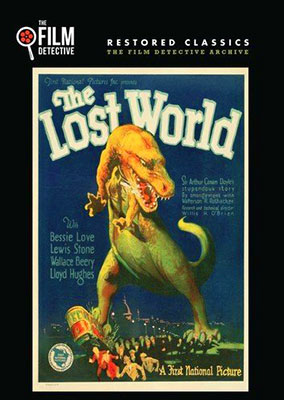 The Film Detective The Film Detective
2015 DVD edition
The Lost World (1925), black & white, 106 minutes, not rated.
The Film Detective,
unknown catalog number, unknown UPC number.
One single-sided, single-layered, Region 0 NTSC DVD-R disc, 1.33:1 aspect ratio image in full-frame 4:3 (720 x 480 pixels) interlaced scan MPEG-2 format, SDR (standard dynamic range), ? Mbps average video bit rate, ? Kbps audio bit rate, Dolby Digital 48 kHz 2.0 mono sound, English language intertitles, no foreign language subtitles; chapter stops; standard DVD keepcase; $9.99.
Release date: 3 November 2015.
Country of origin: USA
|
|
This DVD-R edition has likely been mastered from a 16mm reduction print.
The film is likely to be accompanied by a soundtrack compiled from preexisting recordings.
|
|
USA: Click the logomark to purchase this Region 0 NTSC DVD-R edition from Amazon.com. Your purchase supports Silent Era.
|

|
|
 St. Clair Vision St. Clair Vision
2005 DVD edition
Tales from the Future (1925-1989), black & white and color, 758 minutes total, not rated,
including The Lost World (1925), black & white, 63 minutes, not rated.
St. Clair Vision, PDS88269-3VD, UPC 7-41027-16319-3.
Three single-sided, dual-layered, Region 0 NTSC DVD discs, 1.33:1 aspect ratio image in full-frame 4:3 (720 x 480 pixels) interlaced scan MPEG-2 format, SDR (standard dynamic range), ? Mbps average video bit rate, ? Kbps audio bit rate, Dolby Digital 48 kHz 5.1 stereo sound, English language intertitles, no foreign language subtitles, 4 chapter stops; double-wide three-disc DVD keepcase; $7.98.
Release date: June 2005.
Country of origin: Canada
Ratings (1-10): video: 4 / audio: 4 / additional content: 5 / overall: 4.
|

This DVD edition is a good value for the surprisingly good quality of the 35mm film elements utilized for the natural-speed full-frame video transfer. There is a reason for this as the transfer has merely been duplicated from the Lumivision edition noted above, removing the oversaturated color-toning and tints. Some sections of the source print (or the transfer) are quite dark. The source print has the usual speckling, dust, and other flaws, with a reasonably broad range of greytones (without blasted-out highlights) with holds a great amount of picture information.
The film is accompanied by an LP record playing Scott Joplin piano music (processed for 5.1 sound), pops, crackles and all. It is ludicrous to watch dinosaurs battling it out to uptempo ragtime music.
If you’re cheap, this is the best of the budget editions of The Lost World, which we slightly favor over the oversaturated color of the Lumivision edition but demerit for the distractingly stupid choice of accompanying music. Also, two of the three discs’ labels are swapped (one being the disc with The Lost World on it) — another indication of the level of intelligence among budget video producers.
|
|
USA: Click the logomark to purchase this Region 0 NTSC DVD edition from Amazon.com. Your purchase supports Silent Era
|

|
|
|
Canada: Click the logomark to purchase this Region 0 NTSC DVD edition from Amazon.ca. Your purchase supports Silent Era.
|

|
|
 Navarre Corporation Navarre Corporation
2002 DVD edition
Triple Feature Drama Classics, Volume 8 (1925-1926), black & white and color-toned black & white, 230 minutes total, not rated,
including The Lost World (1925), color-toned black & white, 69 minutes, not rated.
Navarre Corporation, 1631, UPC 7-41027-16319-3.
One single-sided, dual-layered, Region 1 NTSC DVD disc, 1.33:1 aspect ratio image in full-frame 4:3 (720 x 480 pixels) interlaced scan MPEG-2 format, SDR (standard dynamic range), 3.0 Mbps average video bit rate, 192 Kbps audio bit rate, Dolby Digital 48 kHz 2.0 mono sound, English language intertitles, no foreign language subtitles, 6 chapter stops; standard DVD keepcase; $9.98.
Release date: 16 April 2002.
Country of origin: USA
Ratings (1-10): video: 4 / audio: 4 / additional content: 6 / overall: 4.
|

This Navarre DVD presentation has been transferred from a truncated color-toned 16mm reduction print, which is dark in shadow areas and soft of image detail. It has exposure fluctuations that are consistent with most older 16mm prints, and suffers from moderate speckling, dust, splices, and print scuffing. While the natural speed video transfer’s framing is open, the overall quality of this transfer is a bit of a rough go in comparison to other — better and more complete — DVD editions that are available.
The presentation is accompanied by a canned orchestral soundtrack.
|
|
USA: Click the logomark to purchase this Region 1 NTSC DVD of this edition from Amazon.com. Your purchase supports Silent Era.
|

|
|
|
Canada: Click the logomark to purchase this Region 1 NTSC DVD edition from Amazon.ca. Your purchase supports Silent Era.
|

|
|
 Alpha Video Alpha Video
2002 DVD edition
The Lost World (1925), color-tinted black & white, 68 minutes, not rated.
Alpha Home Entertainment,
ALP 4064D, UPC 0-89218-40649-1.
One single-sided, single-layered, Region 0 NTSC DVD disc, 1.33:1 aspect ratio image in full-frame 4:3 (720 x 480 pixels) interlaced scan MPEG-2 format, SDR (standard dynamic range), 6.5 Mbps average video bit rate, ? Kbps audio bit rate, Dolby Digital 48 kHz 2.0 mono sound, English language intertitles, no foreign language subtitles, 5 chapter stops; standard DVD keepcase; $6.98 (raised to $8.98).
Release date: 22 October 2002.
Country of origin: USA
Ratings (1-10): video: 4 / audio: 4 / additional content: 0 / overall: 4.
|
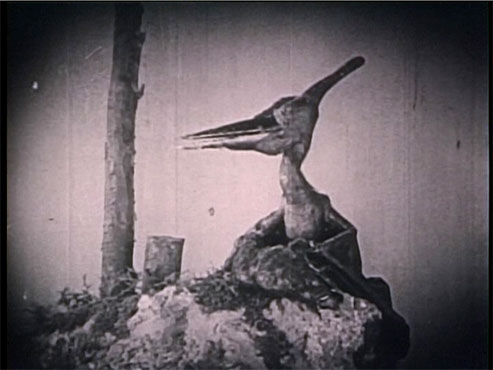
This budget DVD edition is not worth its low cost. This Alpha Video edition has been transferred from a very-good 16mm reduction print, but the video master transfer has been so drastically overcompressed for this disc that portions of the image are slow to shift into correct position as the movements of actors and miniatures move about in this sometimes jittery source print. Sure signs of the noted overcompression are the constant crosshatched MPEG-2 video artifacts that are clearly seen on a computer screen and, especially, on an HD monitor.
The cobbled-together musical accompaniment, from a number of monaural orchestral and pipe organ sources, is at times distorted and can be tough listening for the discerning.
Don’t be cheap. Skip this low-quality disc and spend the few extra bucks for the Image edition recommended above.
|
|
USA: Click the logomark to purchase this Region 0 NTSC DVD edition from Amazon.com. Your purchase supports Silent Era.
|

|
|
|
Canada: Click the logomark to purchase this Region 0 NTSC DVD edition from Amazon.ca. Your purchase supports Silent Era.
|

|
|
 Front Row Entertainment Front Row Entertainment
2003 DVD edition
The Lost World (1925), black & white, 63 minutes, not rated.
Front Row Entertainment, 3743, UPC 0-82554-37432-5.
One single-sided, single-layered, Region 0 NTSC DVD disc, 1.33:1 aspect ratio image in full-frame 4:3 (720 x 480 pixels) interlaced scan MPEG-2 format, SDR (standard dynamic range), 5.5 Mbps average video bit rate, 192 Kbps audio bit rate, Dolby Digital 48 kHz 2.0 stereo sound, English language intertitles, no foreign language subtitles, 13 chapter stops; standard DVD keepcase; $5.98.
Release date: 2003.
Country of origin: USA
Ratings (1-10): video: 3 / audio: 3 / additional content: 1 / overall: 3.
|

This DVD edition has been transferred from a 16mm reduction print that is contrasty and largely devoid of true image detail. It has not been helped by a video transfer that has been overcompressed on DVD.
We find it insulting that Front Row touts this disc as “Digitally Remastered For Superior Picture Quality,” for the visual results are anything but superior. Highlight details are often blasted-out, with shadow details plugged-up to black.
The musical accompaniment is a canned orchestral score that is passable and, at best, generically appropriate to the story’s action. The sole supplementary material is a worthless synopsis of the story. We do not recommend this edition of The Lost World.
|
|
This Region 0 NTSC DVD edition is . . .
|

|
|
 GoodTimes Entertainment GoodTimes Entertainment
2001 DVD edition
The Lost World (1925), black & white, 69 minutes, not rated.
GoodTimes Entertainment,
unknown catalog number, unknown UPC number.
One single-sided, single-layered, Region 1 NTSC DVD disc, 1.33:1 aspect ratio image in full-frame 4:3 (720 x 480 pixels) interlaced scan MPEG-2 format, SDR (standard dynamic range), ? Mbps average video bit rate, ? Kbps audio bit rate, Dolby Digital 48 kHz 2.0 mono sound, English language intertitles, no foreign language subtitles, chapter stops; standard DVD keepcase; $4.95.
Release date: 1 May 2001.
Country of origin: USA
|
|
As with other budget editions of The Lost World, this Good Times DVD edition is likely transferred from a 16mm reduction print and, thus, cannot be recommended.
With so many other editions available, don’t bother chasing this one.
If you own a copy of this disc, please consider loaning it to us to review for documentation purposes. We pay postage both ways.
|
|
USA: Click the logomark to purchase this Region 1 NTSC DVD edition from Amazon.com. Your purchase supports Silent Era.
|

|
|
|
Canada: Click the logomark to purchase this Region 1 NTSC DVD edition from Amazon.ca. Your purchase supports Silent Era.
|

|
|
 IVC IVC
2003 DVD edition
The Lost World (1925), black & white, 150 minutes, not rated.
Unknown video company, IVCF-2164, unknown UPC number.
One single-sided, single-layered, Region 2 NTSC DVD disc, 1.33:1 aspect ratio image in full-frame 4:3 (720 x 480 pixels) interlaced scan MPEG-2 format, SDR (standard dynamic range), ? Mbps average video bit rate, ? Kbps audio bit rate, Dolby Digital 48 kHz 2.0 mono sound, English? language intertitles, optional? Japanese language subtitles, chapter stops; standard DVD keepcase; ¥3800.
Release date: 20 June 2003.
Country of origin: Japan
|
|
This Japanese DVD edition features a theatrical trailer, cast bios, and more.
We suspect that the unusually long running time noted includes the disc’s extras.
North American collectors will need a region-free DVD player to view this edition.
If you own a copy of this disc please consider loaning it to us to review for documentation purposes. We pay postage both ways.
|
|
This Region 2 NTSC DVD edition is . . .
|

|
|
|
Other silent era LLOYD HUGHES films available on home video.
Other SCIENCE FICTION and FANTASY FILMS of the silent era available on home video.
Other silent film music scores by THE ALLOY ORCHESTRA available on home video.
Other silent film music scores by ROBERT ISRAEL available on home video.
|
|

SUPPORT SILENT ERA
USING THESE LINKS
WHEN SHOPPING AT
AMAZON



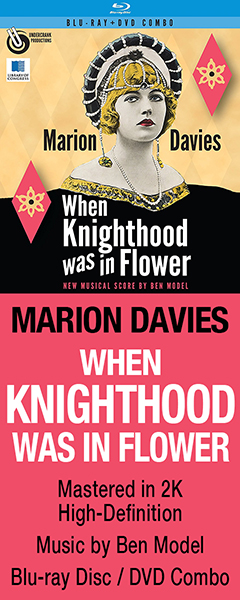





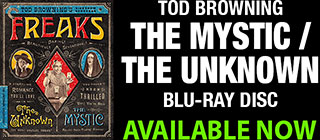


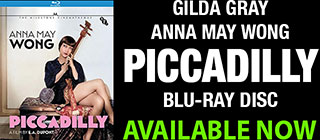








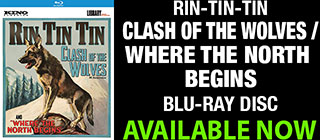









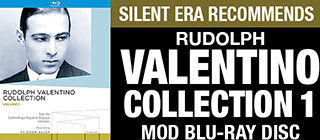



























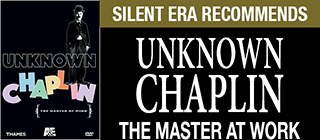

|





































